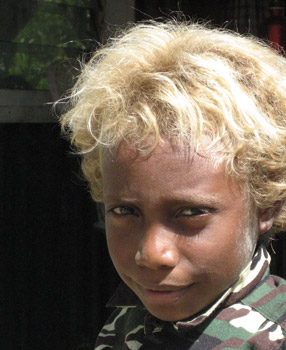SUMMER 2012 CONTENTS
Home
B!g data
What it means for our health and the future of medical research
Statistically significant
Biostatistics is blooming
King of the mountain
Digging data for a healthier world
A singularity sensation
Author Vernor Vinge talks sci-fi health care
On the records
Tapping into Stanford's mother lode of clinical information

DOWNLOAD PRINTABLE
ISSUE (PDF)


in Brief
Blond roots
Pacific Islanders’ golden-locks mystery is solved
By Rosanne Spector
Photography by Sean Myles
Blond hair is rare. So geneticist Sean Myles was amazed by what he saw when visiting the Solomon Islands, an equatorial nation in the South Pacific.
“They have this very dark skin and bright blond hair. It was mind-blowing,” says Myles, who later became a postdoctoral researcher at Stanford, working with genetics professor Carlos D. Bustamante, PhD.
“As a geneticist on the beach watching the kids playing, you count up the frequency of kids with blond hair, and say, ‘Wow, it’s 5 to 10 percent.’”
Myles later learned that blond hair occurs with substantial frequency only in northern Europe and in Oceania, which includes the Solomon Islands and its neighbors. He was so intrigued he arranged a return trip in 2009 to figure out the genetics of the blond trait. He and a friend, scientist Nicholas Timpson, PhD, gathered the data — including hair color measurements and DNA (from saliva samples) — and then they worked with Bustamante and others to analyze it. They published their discovery May 4 in the journal Science.
Many had assumed the islanders’ blond hair was the result of gene flow — a trait passed on by European explorers, traders and others who visited in the preceding centuries. The islanders themselves gave several possible explanations for its presence, says Myles, who is now an assistant professor at the Nova Scotia Agricultural College. They generally chalked it up to sun exposure, or a diet rich in fish, he says.
But this new study shows that blond hair among indigenous Solomon Islanders is the result of a homegrown genetic variant that’s distinct from the gene that leads to blond hair in Europeans. So blond hair arose in both places independently.
Aside from the “gee whiz” factor, the discovery underscores the importance of genetic studies on isolated populations, says Bustamante. “If we’re going to be designing the next generation of medical treatments using genetic information and we don’t have a really broad spectrum of populations included, you could disproportionately benefit some populations and harm others.”
Bustamante is seeking funds to analyze the rest of the data gathered. “For instance, the genetics of skin pigmentation might be different there too — not the same as in Europe or Africa or India. We just don’t know.”

